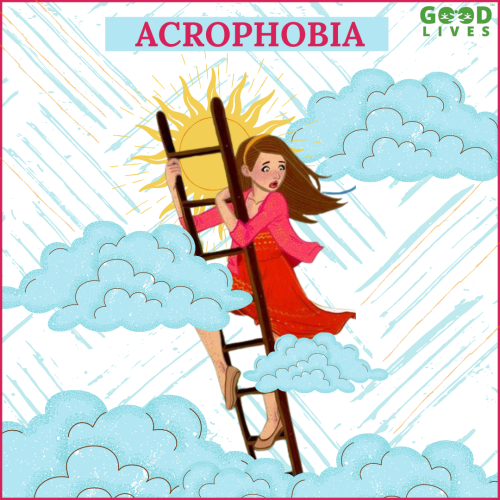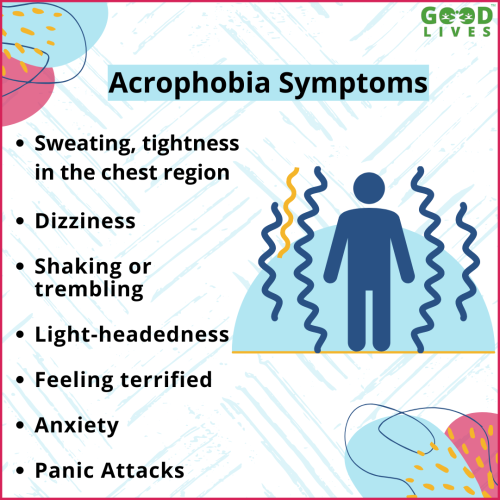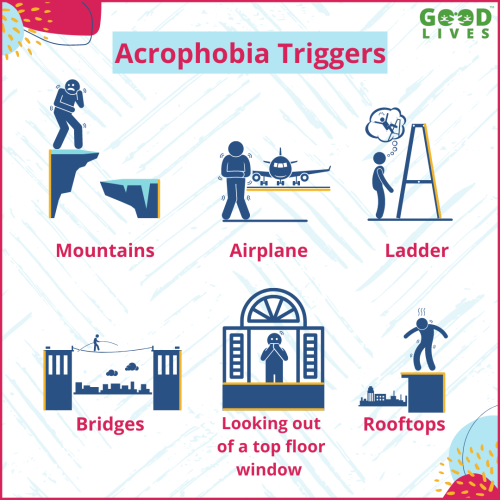Acrophobia

Do you feel that anxiety when you are off the ground? Do you panic when you are riding a transparent elevator? Do you dread going to meetings on higher floors of the building? If the answer to any of these questions is yes then, there is a chance that you may be suffering from Acrophobia, a fear of heights.
This article will help you in understanding all about Acrophobia, from meaning to treatment.
Acrophobia : Meaning
Acrophobia, or fear of heights, is an anxiety disorder. It affects about 2-5% of the population, women more than men. When suffering, people might panic just by being up on a ladder, on a high surface, or by thinking about heights. People who have Acrophobia live their lives by avoiding situations in which they might get involved with anything high up or off the ground.
However, this avoidance often chips away at their quality of life. There are many cases where just looking over a bridge or looking down from a building floor can make your heart race, your palms sweaty, and lead you to a panicked state. The stress caused is strong enough to affect the daily lives of an individual.
Possible Causes of Acrophobia
There are various theories present that defines the cause of acrophobia but none of them can be classified as a lone cause. Some theorists believe since falling from heights threatens the survival of individuals, the slight fear of heights is natural.
To some extent, everybody feels a little discomfort when they are at the highest point in a Ferris Wheel or looking down from the 20th floor of a building. But people with acrophobia have severe effects both physical as well as emotional.
Some believe that fear of heights can be instilled through interaction with their environment. This fear can be developed when a child observes their caregivers experiencing fear around heights or when an individual witnesses a tragedy because of an experience with heights to someone close to them.
It can also happen if they suffer an accident like falling off a tree. The individual might associate the feeling of pain and anguish of the incident with the height itself, thus, developing a fear for life.
Acrophobia Symptoms

Physical and emotional response to it is similar to those experienced by other phobias. Another thing to understand is many people consider Vertigo as the fear of heights. In reality, Vertigo is just a condition where an individual experiences spinning sensations along with dizzy spells. This condition is often experienced by Acrophobic individuals when they are facing any variant of heights making it one of the common symptoms.
Here, people are observed to suffer from some of the following symptoms:
- Increased sweating, tightness in the chest region
- Dizziness or the feeling of losing balance
- Shaking or trembling when facing heights
- Light-headedness, the feeling of passing out
- Feeling terrified or paralyzed in one place
- Anxiety
- Panic Attacks
Acrophobia Triggers

For a person to have a phobia, the fear should persist for 6 months or more. For some people, extreme heights are the triggers responsible to make them understand this fear while for others standing on a ladder or stools, i.e., any kind of height might help in understanding this fear. Acrophobia triggers are different for different individuals and some of them include:
- Cliffs/Mountains
- Flying in an airplane
- Staircases/ladder
- Bridges
- Looking out of a top floor window
- Skyscrapers
- Rooftops
While many of the above have a direct relation with heights, people might confuse Acrophobia, i.e., fear of heights with other phobias like Aerophobia(fear of flying), Bathmophobia (fear of slopes and stairs), etc.
Acrophobia Diagnosis
Its diagnosis can be done by a mental health professional. ICD-10 is the 10th revision of the International Statistical Classification of Diseases and Related Health Problems(ICD), a medical classification list by the World Health Organization(WHO). ICD-10 is used for the diagnosis of fear of heights.
There are certain self-reports that individuals can use to diagnose this phobia on their own like Acrophobia Questionnaire(AQ), Attitude Towards Heights Questionnaires (ATHQ), and Behavioural Avoidance Tests (BAT).
However, in such self-reports, individuals often overestimate the dangers and question their abilities to answer queries related to heights. Therefore, it is advised to have such an assessment of phobia via mental health professionals only.
Acrophobia Treatment

When it comes to phobias, avoiding situations is considered the best treatment method by a majority of the population, easy and effective. But sometimes avoiding something like this might make the situation worse. Acrophobia is treatable but with patience, time, and dedication. Some of the treatment methods include:
- Cognitive Behavioral Therapy: Behavioral techniques that expose the individual to the feared situation (heights, in this case) are employed and the patient is trained in various ways how to stop panicking in such situations. With the advancement in technology, Virtual Reality(VR) has played a great role in helping people overcome this fear. VR has saved time and money as there is no need to be “on the location” (in this case, heights). It is also observed that by using such techniques, people with Acrophobia can cope with heights better after only a few sessions.
- Medication :
Acrophobia cannot be directly treated by any medications, however, some medications can be used to help with the symptoms of panic & anxiety. For example, Beta-blockers can be used to keep the heart rate and blood pressure steady along with reducing other anxiety symptoms. - Other methods: Can be meditation, yoga, deep breathing exercises, etc. which reduce the effects of anxiety and stress and help cope with one’s fears.
What to Keep in Mind:
Acrophobia is one of the most common phobias in the world. If you or someone close to you have Acrophobia and it has begun to affect the daily activities to the point that you/they avoid certain situations because of it, the time has come to seek professional help. A therapist can help with the treatment process and with time you or someone close to you will be able to overcome Acrophobia and what could be a better place than visiting Goodlives.
0 Comments